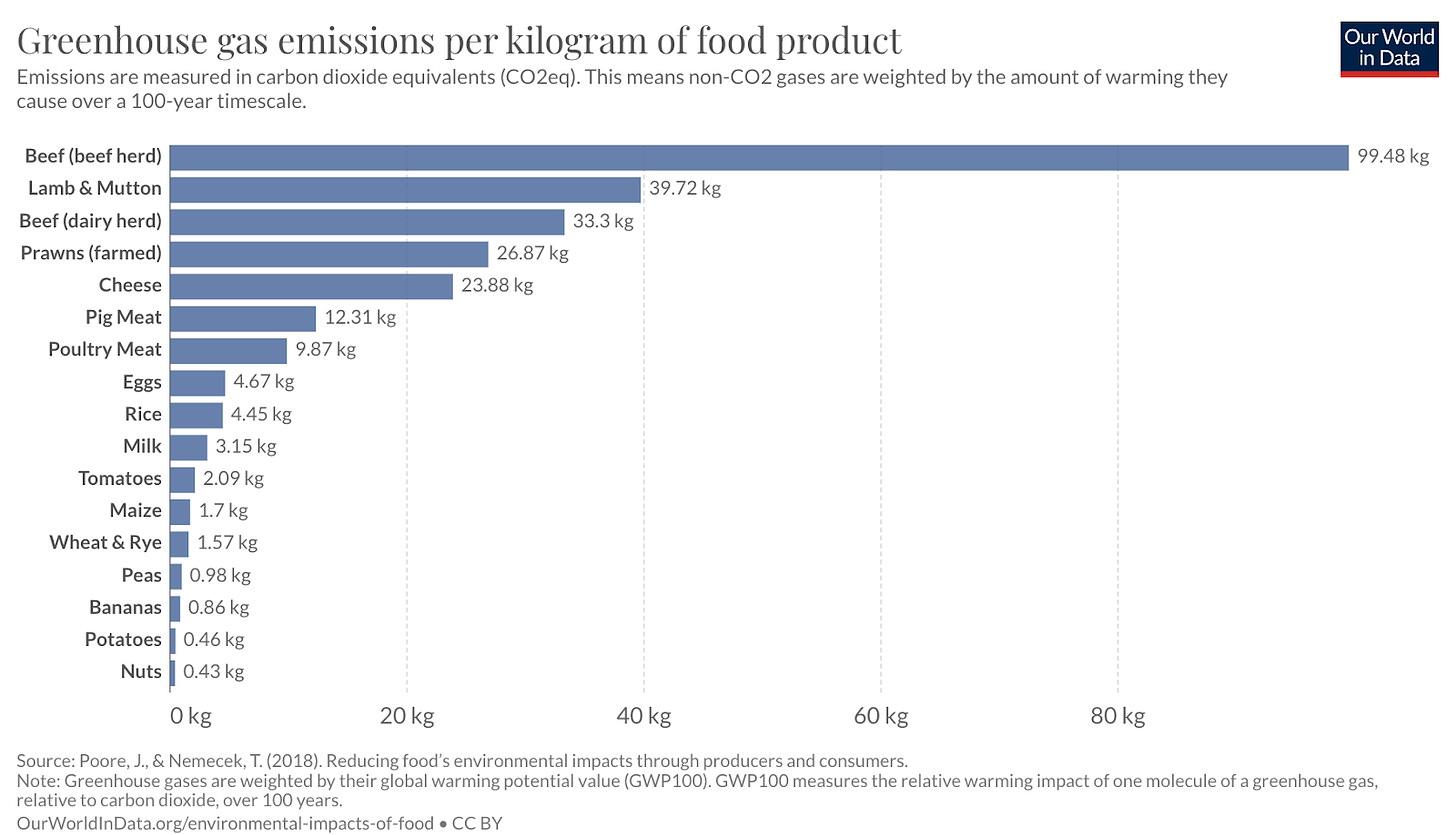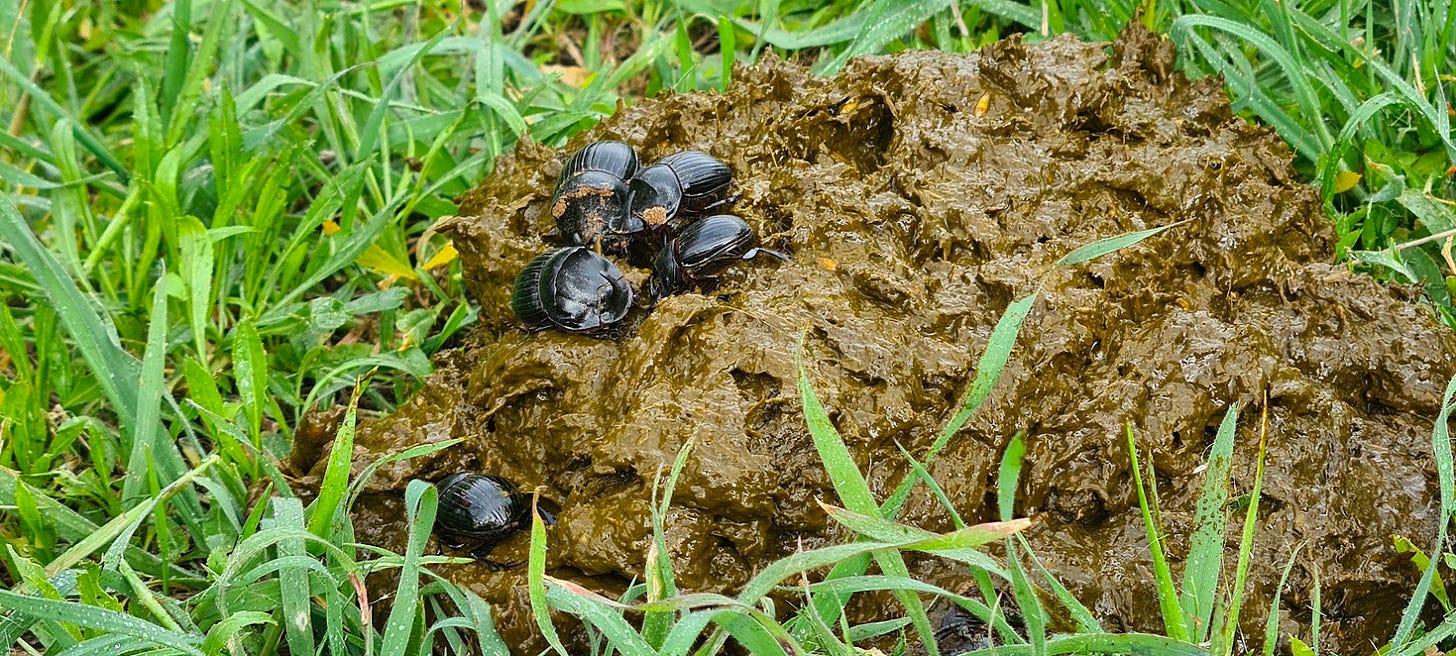Climate and Big Beef
Chris Gill

“San Antonio entrepreneur and rancher Lew Moorman calls BS on fake beef.
NOTE: this article was originally published to Substack by Lew Moorman on January 15, 2023.
There is likely no bigger boogeyman of the climate battle than beef.
Almost every news outlet consistently shames meat eaters as they prop up plant based alternatives such as the Impossible Burger.
This position has become so entrenched that it is hardly questioned. Tamar Haspel and George Monbiot have led the charge outlining the negative consequences of eating beef. They are right to point a finger at the industrial beef system. But, they fail to see the whole picture – and propose too radical a solution as a result.
Let’s see if I can convince you to reconsider the real beef burger.
Beef production requires cows. And cows, well, they come with two big flaws when it comes to carbon emissions: they emit methane and need a lot of land to grow.
You may have seen this chart (or some version of it):

The data comes from a comprehensive study published in Science magazine in 2018. It is a thorough review of the food system and has been used as the basis for almost all articles and thinking on the topic. It has been practically anointed as the final word on climate and food.
You now see why the cow has been relegated to the naughty list. But some very important nuance is being missed here.
Let’s start with methane – more than half the problem. As you surely know, the cow uses their rumen to ferment grass into nutrients and eventually protein. It’s a neat trick (that humans can’t do) but has a side effect: methane that escapes from cow burps. And, methane is a nasty greenhouse gas that has 28x (!) the impact of typical carbon dioxide.
But, methane is unusual in another, very important way. Unlike carbon dioxide that can stay in the atmosphere as long as 1000 years, methane dissipates in around 12 years.
Why does this matter?
Well, ruminants have been wandering the planet for at least 5 million years. Lots of them. Think about the buffalo of pre-colonial America. Most estimates put the number between 50-100 million. And don’t forget elk, antelope and deer. As you may have noticed we have displaced vast herds of these animals as we have settled the land. But, now we have cows – about 90 million of them here in the US. Given the 12 year cycle, if a ruminant population is stable over 12 years (or millions) the methane in the atmosphere will remain stable. New methane is only added if we increase the population. And only massively increases if we massively increase the numbers.

Ruminants have long roamed the planet – in huge numbers.
Now, estimating numbers of total animals now vs sometime in the past is not easy. But one thing is for sure: cows have displaced other methane belching ruminants making their NET emission gains quite low or even non-existent. The graph above assumes all cow based methane emissions are net increases to the atmosphere – like any carbon from fossil fuel burning is a net addition (since it has been less than 1000 years since we started that activity). That is flat out not the real story given the very short methane cycle.
To validate this logic, most recent studies support the idea that marginal gains in methane are not from cows, blaming other activities such as natural gas exploration, rice farming and other natural emissions.
All this said, you could still argue to remove cows. Even if we have had stable methane from ruminants for centuries, eliminating them now would drive big greenhouse gas losses after 12 years. That is true. But, do we want to remove all cows from the land? That gets us to the other big issue: land use.
There is no question cows need a lot of land. In my region of Texas one cow can require 30 to 50 acres to grow. Wow – what a waste, right? Not so fast. As mentioned, ruminants have been part of grassland ecosystems for millions of years. Think maybe they matter? Well, the biology of soil and grasses actually depend on ruminants – their grazing, their excrement and their stomping. All of it is part of a natural ecosystem.
When cows tug on grasses, their roots produce exudates (sugar), adding nutrients to the soil. And their excrement…well there are dozens of beetle species evolved specifically to consume it and return it deep into the soil (as they burrow) adding to organic life and increasing the soil health. When buffalo were free to graze the country, they were part of a process that created feet of rich (carbon dense) soil and prairie grasses as tall as humans.

Dung beetles thrive on piles – returning nutrients to the soil.
Ruminants are a critical part of the rangeland ecosystem – period. As the Chief Conservation Office of the Auduban Society has said, “No cows, no grass, no birds.” Regenerative grazing which seeks to replicate natural grazing patterns of historic ruminants goes even further and has been proven to restore native grasses, increase plant and animal diversity all while building rich organic soil – actually removing carbon from the air. Graze cows in a way that mimics hostoric grazing patterns, and nature starts to heal.
So why the big penalty for land use in the analysis? The study gives no credit to these benefits and assumes deforestation occurs to accommodate cows. And, some deforestation does surely happen. When the Amazon rainforest is cut for animal grazing, it is a horrible ecological trade. But, forests are cleared for crops as well. Desperate people in these regions will prioritize surviving over the life of the planet. They must produce food. The world does not depend on these regions for grazing – it is a local crisis. There are 650 million acres of natural grasslands in the US. And billions worldwide. Many are not grazed. All could be grazed at lower cost than clearing natural forests. It is a political problem of how to feed the poor folks near rich rainforests. Getting rid of cows altogether is akin to eliminating useful drugs because they have bad side effects for some.
So methane is vastly overstated and land use could actually be a positive in most regions?
Of course, it’s not quite that simple. I am describing well managed pasture raised beef. While it remains a small percentage of beef today (and regenerative even less) it is growing and more options are coming to market.
Most mass industrial beef does have many negative externalities. Overgrazing degrades land and soil. It is common. And feedlots are where most beef is finished. These factories breed disease, leak toxic excrement and depend on highly fertilized (and chemically laced) cash crops. This combination is ecologically harmful – not just for the climate. Of course the industrial soy of the Impossible Burger has pretty much all the same issues.
The real possibility is regeneratively raised beef. Pasture grazed for life, working in harmony with nature to build it back to health – all while putting carbon back in the soil. And, you get your burger too.
Good Links
- Full disclosure – I have a dog in this fight. I am spending a good deal of time and money on regenerative grazing – my own land and a $30m fund to invest in the space.
- Meet the original regenerative graziers – the “carbon cowboys” including the great Allen Williams and Gabe Brown, two of the true pioneers (and gentlemen) in the industry. Great 12 min video outlining how they raise cows to heal the planet. Still don’t believe it?
- A several year effort to review ALL the studies on red meat makes clear finding: there is weak (to no) evidence that meat causes major disease. Most correlations are tied to other habits of meat eaters (ahem, french fries and cigars).
- Scott Alexander makes the controversial case that most news (including the worst of it) contains few lies even when totally misleading. The chart above is a good example. Cows do indeed emit a lot. But, the methane cycle is critical information to understanding the whole story.
- Unlimited clean energy exists. It just has a marketing problem.
- Speaking of beetles, Jack White knows his stuff about the musical Beatles:
—
For more posts like this, in your inbox weekly – sign up for the Restoring Diversity Newsletter
